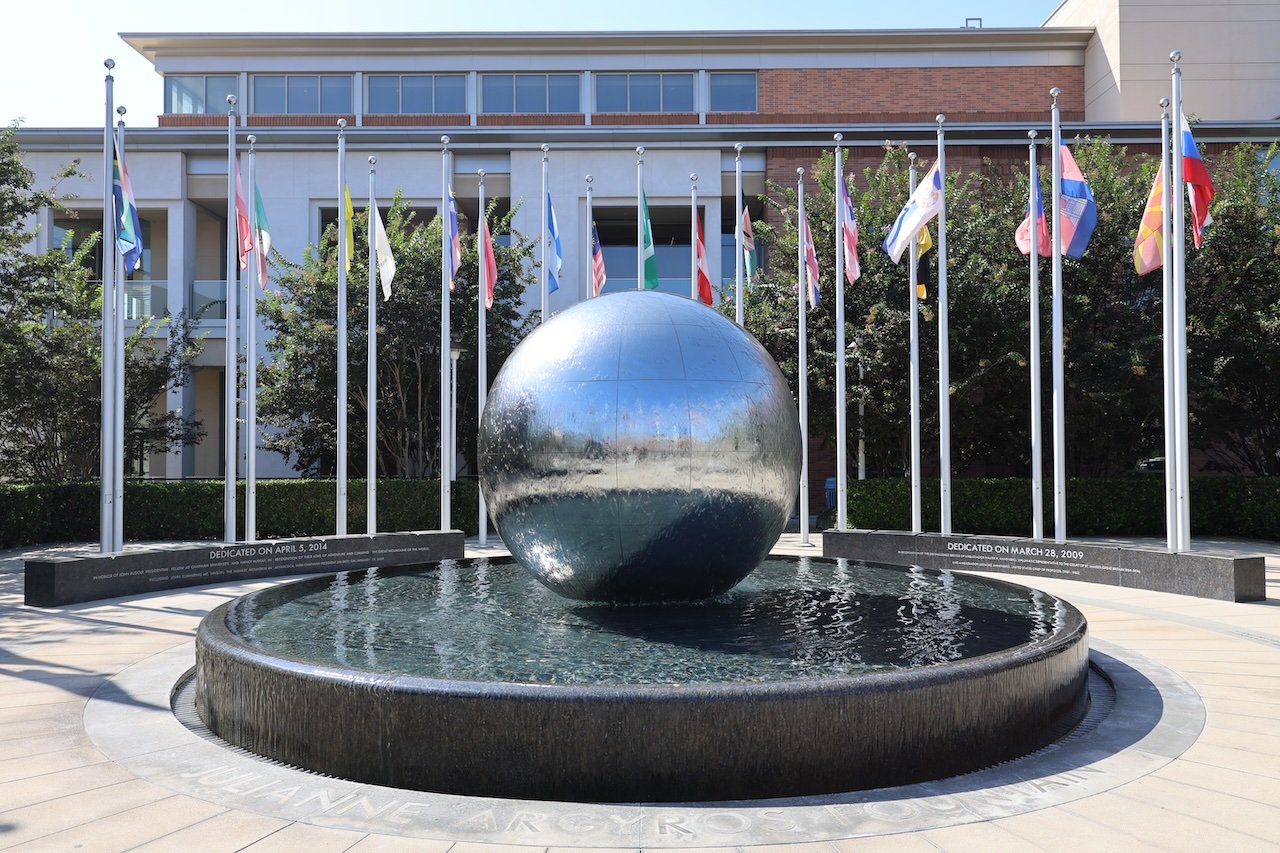Chapman University Campus: Notable Buildings & Points of Interest
Chapman University is a private university located in Old Towne Orange with a beautiful campus. You don’t have to be a student to appreciate it, either—the campus is open to the public.
Read on for a list of the top points of interest, plus learn more from Collette Creppell, Chapman University’s Vice President of Campus Planning and Design.
Piece of the Berlin Wall
This piece of the Berlin Wall is located in a small secluded garden space, where visitors can reflect on the historical significance of the 1989 fall of the concrete structure marking the end of the Cold War.
Piece of the Berlin Wall
Global Citizens Plaza
Global Citizens Plaza opened up in 2014 and features a giant metal globe in a fountain. It is surrounded by flags of many different countries.
Attallah Piazza
Attallah Piazza is a centrally located place for students to meet on campus. In the middle of the plaza is a fountain with a view of Leatherby Libraries. It’s also conveniently located next to a Starbucks.
Memorial Hall
Perhaps the most photographed building on the Chapman Campus, Memorial Hall almost looks like a building you’d find on a movie set.
Reeves Hall
Musco Center for the Arts
Roosevelt Hall
Smith Hall
Sandi Simon Center for Dance
The Hilbert Museum
Collette Creppell, AIA, Vice President of Campus Planning and Design, Chapman University
What architectural philosophy influenced the design of Chapman University’s campus during its major construction periods?
The architectural philosophy that has influenced the design of Chapman University’s campus during its major construction period over the past twenty years has been one of accessibility, approachability, beauty, and aspiration. While drawing on traditions and the architectural context of the historic buildings with which the Chapman campus is graced, the philosophy has been to extend those traditions and that context with design that embraces the present and speaks with a fresh voice to the future.
How does Chapman’s unique design enhance the student and faculty experience on campus?
Chapman University’s campus planning and architectural highlights prioritize place-making, connections between spaces, and the nurturing of community space, while maintaining a strong sense of family in the forms and palette of the campus buildings and spaces.
How do you ensure that new architectural projects complement the existing campus aesthetic?
Collette Creppell
For new architectural projects to complement the existing campus aesthetic, we delight in using-- sometimes subtly, sometimes overtly, sometimes through re-invention and transformation—the existing forms, massing, scale, materials and color palette of the historic buildings in the campus context.
Which buildings are considered the most iconic or most representative of Chapman University?
The most iconic buildings of the Chapman University campus in Orange are the assemblage of historic buildings arrayed around the Bert Williams Mall fronting N. Glassell Street just above Palm Avenue. Ironically, one of the five buildings thereof is new construction, Doti Hall, dating from 2013, designed to complete the array around the iconic campus green space. The other four are listed on the National Register of Historic Places and were originally buildings of Orange Union High School. They include:
Reeves Hall (1913), Smith Hall (1913), Memorial Hall (1921), and Founder’s Hall (later renamed Roosevelt Hall) (1922).
Chapman is located right next to the historic Orange Circle. How does that influence the design of the campus or the campus experience?
The historic Orange Circle (or Plaza) creates a compelling physical and visual anchor for Chapman’s campus. The campus begins two short blocks above the Circle. The steady stream of students, faculty, and visitors between the cultural and historical heart of Orange, CA and the campus makes for a lively community. Old Towne Orange bustles with students, faculty and staff joining the rest of the community in the cafes, restaurants, vintage clothing and antique shops, and pubs. Conversely, the campus is animated with community members strolling, biking, walking, or attending dance, theatre, music, art, screening, and lecture events on campus.
Recent architectural highlights on the Chapman University campus in Orange, CA include:
The 88,000 square feet Musco Center for the Arts, opened in 2016, provides a state-of-the-art venue with acoustics by worldrenowned Yasuhisa Toyota of Nagata Acoustics. The Musco Center boasts an intimate seating chamber with 1,044 seats on three levels and a full-scale stagehouse. Providing world-class arts education and artistic achievement, the Musco Center can accommodate full-scale Broadway-style productions, dance companies, symphonies, orchestral work, and operas, as well as spoken theater, chamber performances, jazz, and popular music. The Musco Center for the Arts showcases productions by Chapman University’s College of Performing Arts, including music, dance, and theatre. The Center serves as a dynamic focal point for campus life and the broader community. Architects: Pfeiffer Partners.
The Keck Center for Science and Engineering, located at the prominent corner of Walnut Avenue and Center Street and opened in 2018, is the home of Chapman’s Schmid College of Science and Technology and Fowler School of Engineering. The new building adds 140,000 SF of educational space and two levels of below grade parking. The Center presents a permeable, welcoming face to the campus and surrounding community. Architect: AC Martin.
Following the opening of the Keck Center for Science and Engineering, the final phase of the project, the north wing was opened and dedicated in 2021 as the Swenson Family Hall of Engineering as the home of Chapman’s newest school, the Fowler School of Engineering (opened 2019). Architects: AC Martin.
Chapman’s recently opened Sandi Simon Center for Dance, opened in January 2023, has appeared on the cover of Architectural Record and been recognized with awards at the state and national level, including awards and recognition by the American Institute of Architects (AIA) California, the national Society of College and University Planning, the California Preservation Society, AIA Los Angeles, and AIA Orange County. This project, which received FitWel certification for its wellness features, preserved and transformed the national historic Packing House in Old Towne Orange into a soaring, dynamic space for teaching and performance. Architects: Lorcan Herlihy Architects. Opened January 2023.
The Hilbert Museum of California Art expansion, tripling the museum’s square footage and reviving a historic Millard Sheets mosaic, was completed and opened in February 2024. It is located across from the historic train depot between Cypress Street and Atchison Street. A new public courtyard serves as a gateway from the Orange Metrolink station to Chapman University and to Old Towne Orange. Architects: Johnston Marklee Architects. Opened February 2024.
Currently underway between N. Olive and N. Lemon Streets, just above Walnut Avenue, is the restoration of the historic Killefer School, the national register landmark where desegregation took root, into Chapman University’s Institute for Quantum Studies and the state-of-the-art new North Laboratory building. Architects: Ehrlich Yanai Rhee Chaney Architects (EYRC). Anticipated opening: May 2025.














